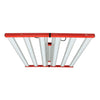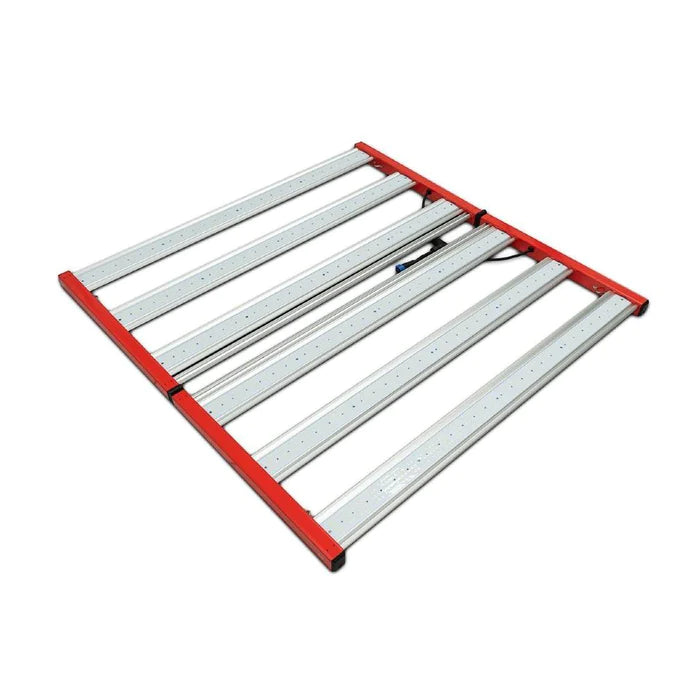
Measuring Performance of Horticultural Lighting Systems
, by BVV Team, 10 min reading time

, by BVV Team, 10 min reading time
In this article, we give growers an overview of the key metrics that should be used when comparing the performance of LED grow lights.
Written for BVV™ by Randy Shipley, RSX
August 4, 2021
In our latest article, How Spectral Light Quality Impacts Plant Growth (July 27, 2021), we discussed the importance of full spectrum LED lights and how advances in LED technology now allow LED grow light manufacturers to optimize the right spectrum for plant rotations (vegetative to flowering) to maximize strong growth, minimize transition times, and maximize yields. In this article, we give growers an overview of the key metrics that should be used when comparing the performance of LED grow lights.
Remember that photosynthetically active radiation, often abbreviated PAR, light is the wavelengths of light within the 400 (blue) to 700 (red) nanometers (nm), which plants use in the process of photosynthesis. This spectral range corresponds generally with the range of light visible to the human eye. Photons at shorter wavelengths tend to be so energetic that they can be damaging to cells and tissues, but are mostly filtered out by the ozone layer in the stratosphere. Photons at longer wavelengths do not carry enough energy to allow photosynthesis to take place.
PAR is not a measurement itself, but the type of light needed to support photosynthesis. The most important metrics for comparing LED lights are PPF (photosynthetic photon flux), PPFD (photosynthetic photon flux density) and PPF Efficacy (photosynthetic photon flux efficacy).
Horticulturalists generally follow a 1% rule: For most crops, 1% more light means 1% more yield. Hemp plants typically follow this classic rule of thumb; however, there is a point of saturation where the rate of increasing yield diminishes.
See LEDs Magazine - Growing with Horticultural SSL
Growers should also be wary of a single PPFD measurement which doesn’t tell you much. Some LED manufacturers tout an extremely high PAR measurement directly under the fixture by simply clustering the LEDs closely together and using a narrow beam angle. When you think about a targeted PPFD (or light intensity), you must also consider coverage area of a light. Think of it this way – the higher you hang a light over your plant canopy, the less PPFD the canopy receives, same as if you put a flashlight on a counter and raise it, the beam increases in size but diminishes in brightness. This same law of physics will occur with your grow light.
Since most LED lighting systems centralize the LEDs into a small fixture footprint, these systems naturally produce very high PPFD levels directly under the fixture with diminished levels, in some cases, just a short distance from the fixture. Thus, if you are growing in a large canopy area (say, a 50’ x 40’ grow room), you need to review the PPFD levels over the entire area and calculate the average light level the lighting system is providing across this coverage area. Light uniformity across the grow area is extremely important and can vary significantly, so beware of LED manufacturers that do not publish complete PAR maps to validate that their light can deliver both high and uniform PPFD values across an entire canopy.
Two things for growers to consider are PPF (the amount of PAR emitted from the fixture) and the LED’s beam angle. LEDs with a lower beam angle – 90° instead of the standard 120° – can help contain light loss but this can create areas of highly contained light in the center of your grow, causing stress or “bleaching” – where the tops of the colas turn frosty white. Other reactions include fox tailing and can even cause a plant to become a hermaphrodite.
Using 120° beam angles will give you more uniform coverage which, in turn, creates less stress, a more even canopy, and better yields overall. If you are in large areas, having multiple lights with this beam angle will overlap and intensify the overall lighting of your canopy. For enclosed, smaller grow areas, we recommend using reflective material on walls to contain your light and minimize light loss, while adding more light uniformity to your plants.
When addressing "coverage," there are several variables to conder – your target PPFD, the distance between the fixture and the plant, and the amount of light you are trying to get at the canopy top. A good 680W LED fixture should easily cover a 6’ x 6’ area in veg and maximum 5’ x 5’ in flower, but it depends if you are using a single light, hanging in a grid of lights (like 5 rows each with 5 lights), and the distance the lights are hung above the plants.
Let’s face it – LED lighting manufacturers have not been transparent for years, so it is time this industry “grew up” and provided facts backed by science. Before investing in the proper horticulture lighting system to meet your personal or commercial cultivation needs, you need to know the PPF, PPFD, and PPF efficacy to make informed purchasing decisions. It is also importance that you understand the spectrum totals and percentages to maximize growth and yields.
The DesignLight Consortium (the DLC®) Horticultural Lighting Program is a suite of tools and resources to enable widespread adoption of energy-saving LED technology in the horticultural lighting sector. Working in partnership with utilities, energy efficiency programs, and the lighting industry, the DLC maintains a Qualified Products List (QPL) that allows horticulturalists to find, understand, and compare the performance of LED-using horticultural lighting fixtures that may be eligible for utility incentives and rebates. This is like the FDA’s Energy Star designation for energy efficient appliances. See DLC Horticultural Light Qualified Product Listing
Using the DLC QPL for horticultural lights, you can easily compare different LED lights for total PPF as well as wattage used and photons within the key spectral ranges that will maximize your cultivation efforts. Also, beware of any LED manufacturer whose products are not listed and approved by DLC. Chances are they either do not meet the mechanical requirements for safety or do not want their light output and performance to be known – because it does not meet their claims or measure up to the rest of the industry
Growers also need to know that Illinois became the first state to require cultivators to use LED fixtures that are on the DLC QPL, with others expected to follow including CA, PA, NY, and NJ. CA is also requiring all current growers to switch to LEDs by 2022, and MA requires no more than 36W per square foot of canopy – so LEDs are the only option!
No. In comparing horticultural lights, do not confuse watts, which measure electrical input, with light output. Remember, watts are a system input and do not grow plants. What growers care about is system output – how much light a fixture emits per watt of electricity, or PPF efficacy, measured by μmol/J. Light (not wattage) grows plants, and you need to validate how much light a fixture emits. It sounds simple, but 99.9% of horticulture lighting companies overstate or do not report this metric.
Today, it is very easy to design an efficient LED lighting system that can deliver light levels that exceed HPS lighting levels, but not all LED fixtures are created equally. High efficiency LEDs, power supplies (drivers) and optical components cost more than less efficient components, and many LED light manufacturers use lower quality components to increase profit margins – resulting in a less expensive, but inefficient, lighting system that uses the same electricity as more efficient systems. Bottom line – watts, dollar/watts and watts/square foot measures are not useful measures that should be considered when buying a lighting system.
No. Lumens is a rating of how bright a light appears to the human eye, which has nothing to do with photosynthesis. In simple terms, lumens (or lm) are a measure of the total amount of visible light to the human eye from a lamp or light source. However, since human vision is not correlated to photosynthetic grow rates, total lumens is a valueless metric. As a rule, if a lighting company promotes lumens for a horticulture lighting system, they should not be selling horticulture lighting systems.
Since LED and fixture efficiency varies widely, the number, the wattage and the brand of the LED is not a meaningful metric. Your main concerns should be focused on: (i) total PPF output, (ii) providing full spectrum, (iii) a quality warranty from a U.S.-based company, and (iv) the safety of the fixture you are choosing.
LED manufacturers are constantly creating new products that emit more of the light you seek. Manufacturers are also constantly creating higher efficiency drivers with new current levels (amperage) that increase the total PPF for the fixture you seek. It is the rule of the electronics industry as a whole – everything just gets better, faster, and cheaper over time.
To get the best LED grow light for yourself, spend some time on education and research. It will pay off with better yields, taste and overall quality.
About the contributing author
Randy Shipley is a co-founder and the President of RSX Enterprises and is responsible for sales, marketing, product development and technology. He also leads RSX’s design, build and facility start-up advisory services team, with a focus on assisting cultivators with facility and floor plan design assistance for lighting, benching, HVACD and other critical growing systems.
Randy Shipley
randy@rsxenterprises.com
(312) 446-4678
www.cultivationdesignbuild.com


